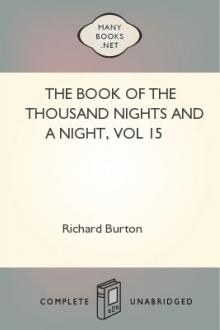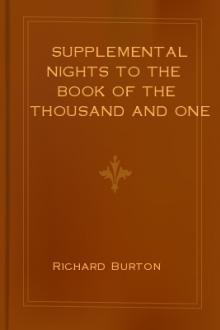The Book of the Thousand Nights and a Night, vol 15 by Sir Richard Francis Burton (classic romance novels .TXT) 📖

- Author: Sir Richard Francis Burton
- Performer: -
Book online «The Book of the Thousand Nights and a Night, vol 15 by Sir Richard Francis Burton (classic romance novels .TXT) 📖». Author Sir Richard Francis Burton
[FN#175] i.e. having enjoyed the woman.—R.F.B.
[FN#176] The reader will doubtless recollect the resemblance which the plot of this lesson bears to Pope’s January and May, and to one of Fontaine’s Tales. Eenaiut Olla acknowledges his having borrowed it from the Brahmins, from whom it may have travelled through some voyage to Europe many centuries past, or probably having been translated in Arabic or Persian, been brought by some crusader, as were many Asiatic romances, which have served as the groundwork of many of our old stories and poems.—Scott.
[FN#177] In Scott (vi. 352) “Adventures of Aleefa and Eusuff.”
This long and somewhat longsome history is by another pen, which is distinguished from the ordinary text by constant attempts at fine writing, patches of Saj’a or prose-rhyme and profuse poetry, mostly doggerel. I recommend it to the student as typically Arabian with its preponderance of verse over prose, its threadbare patches made to look meaner by the purpureus pannus; its immoderate repetition and its utter disregard of order and sequence. For the rest it is unedited and it strikes me as a sketch of adventure calculated to charm the Fellah-audience of a coffee-house, whose delight would be brightened by the normal accompaniment of a tambourine or a Rab�bah, the one-stringed viol.
[FN#178] This P. N. has occurred in vol. vi. 8, where I have warned readers that it must not be confounded with the title “Mah�r�j”=Great Rajah. Scott (vi. 352) writes “Mherejaun,” and Gauttier (vi. 380) “Myr-djyhan” (M�r Jah�n=Lord Life).
[FN#179] I need not inform the civilised reader that this “feeling conception” is unknown except in tales.
[FN#180] i.e. “The Slim-waisted.” Scott (vi. 352) persistently corrupts the name to “Aleefa,” and Gauttier (vi. 380) follows suit with “Alifa.”
[FN#181] In text “Al-Istikhr�j,” i.e. making “elegant extracts.”
[FN#182] These lines are the merest doggerel of a strolling R�w�, like all the pi�ces d’occasion in this MS.
[FN#183] Which are still worse: two couplets rhyme in ��n�, and one in ��l�, which is not lawful.
[FN#184] In text “Dayr Nashsh�bah,” a fancy name.
[FN#185] So in text: the name is unknown to me; its lit. meaning would be, “of high-breasted Virgins.”
[FN#186] In text “Al-Jay’a” which is a well-omened stone like the ‘Ak�k=carnelian. The Arabs still retain our mediaeval superstitions concerning precious stones, and of these fancies I will quote a few. The ruby appeases thirst, strengthens cardiac action and averts plague and “thunderbolts.” The diamond heals diseases, and is a specific against epilepsy or the “possession”
by evil spirits: this is also the specialty of the emerald, which, moreover, cures ophthalmia and the stings of scorpions and bites of venomous reptiles, blinding them if placed before their eyes. The turquoise is peculiarly auspicious, abating fascination, strengthening the sight, and, if worn in a ring, increasing the milk of nursing mothers: hence the blue beads hung as necklaces to cattle. The topaz (being yellow) is a prophylactic against jaundice and bilious diseases. The bloodstone when shown to men in rage causes their wrath to depart: it arrests hemorrhage, heals toothache, preserves from bad luck, and is a pledge of long life and happiness. The “cat’s-eye” nullifies Al-Ayn=malign influence by the look, and worn in battle makes the wearer invisible to his foe. This is but a “fist-full out of a donkey-load,” as the Persians say: the subject is a favourite with Eastern writers.
[FN#187] Or white lead: in the text it is “Sap�daj,”
corresponding with the “Isfidaj” of vol. vi. 126.
[FN#188] In the text “Bashkh�nah”; corr. of the Pers.
“Peshkh�nah”=state-tents sent forward on the march.
[FN#189] This phrase, twice repeated, is the regular formula of the R�w� or professional reciter; he most unjustifiably, however, neglects the “Inshallah.”
[FN#190] The revetment of the old wells in Arabia is mostly of dry masonry.
[FN#191] [Ar. “Taw�n�s,” with a long final to rhyme with “Kaw�d�s,” instead of the usual “Taw�nis,” pl. of “Taunas,” which Dozy (Suppl. s.v.) identifies with the Greek in the sense of cable.—ST.]
[FN#192] In Arab. “Haj�rata ‘l-Bahram�n.”
[FN#193] In text “Zamak�-h�.”
[FN#194] I can see little pertinence in this couplet: but that is not a sine qu� non amongst Arabs. Perhaps, however, the Princess understands that she is in a gorgeous prison and relieves her heart by a cunning hint.
[FN#195] I again omit “Saith the Reciter of this marvellous relation,” a formula which occurs with unpleasant reiteration.
[FN#196] i.e. she cried “Astaghfiru ‘llah” (which strangers usually pronounce “Astaffira ‘llah”); a pious exclamation, humbling oneself before the Creator, and used in a score of different senses, which are not to be found in the dictionaries.
[FN#197] In vol. viii. 183, there are two couplets of which the first is here repeated.
[FN#198] [Here the translator seems to read “Khams Ghaff�r,”=five pardoners,where however, grammar requires a plural after “khams.”
I take “khams” to be a clerical error for “Khamr”=wine, and read the next word “‘uk�r,” which is another name for wine, but is also used adjectively together with the former, as in the Breslau Edition iv. 6 “al-Khamr al-‘uk�r”=choice wine.—ST.]
[FN#199] I understand this as the cupbearer who delights the five senses.
[FN#200] In the original we have, “Saith the Sayer of this delectable narrative, the strange and seld-seen (and presently we will return to the relation full and complete with its sense suitable and its style admirable), anent what befel and betided of Destinies predestinate and the will of the Lord preordinate which He decreed and determined to His creatures.” I have omitted it for uniformity’s sake.
[FN#201] Meaning “The easy-tempered.” Scott (vi. 354) writes “Sohul.”
[FN#202] In text “Lit�m”=the mouth-band for man: ii. 31, etc. The “Mutalathsim�n” in North Africa are the races, like the Taw�rik, whose males wear this face-swathe of cloth.
[FN#203] “Drowned in her blood,” says the text which to us appears hyperbole run mad. So when King Omar (vol. ii. 123) violently rapes the unfortunate Princess Abr�zah “the blood runs down the calves of her legs.” This is not ignorance, but that systematic exaggeration which is held necessary to impressionise an Oriental audience.
[FN#204] For this allusion see vol. v. 191.
[FN#205] This physical sign of delight in beauty is not recognised in the literature of Europe, and The Nights usually attributes it to old women.
[FN#206] In text “Him�”=the private and guarded lands of a Badawi tribe; viii. 102.
[FN#207] In text “Daylak�.”
[FN#208] A small compact white turband and distinctive sign of the True Believers: see vol. viii. 8.
[FN#209] [The words in the text seem to be: “wa Talattuf Alf�zak wa Ma’�n�k al-his�n”=and for the pleasingness of thy sayings and meanings so fine and fair.—ST.]
[FN#210] [The Arabic seems here to contain a pun, the consonantic outline of “Tasht”=“basin” being the same as of “tashshat”=she was raining, sprinkling.—ST.]
[FN#211] In Arab. “Y� W�rid”: see vol. iii. 56.
[FN#212] The growing beard and whisker being compared with black letters on a white ground.
[FN#213] In the text these seven couplets form one quotation, although the first three rhyme in –-�ru and the second four in-
-�ru.
[FN#214] This “diapedesis” of bloodstained tears is frequently mentioned in The Nights; and the “Bloody Sweat” is well-known by name. The disease is rare and few have seen it whilst it has a certain quasi-supernatural sound from the “Agony and bloody sweat” in the Garden of Gethsemane. But the exudation of blood from the skin was described by Theophrastus and Aristotle and lastly by Lucan in these lines:—
—Sic omnia membra Emisere simul rutilum pro sanguine virus.
Sanguis erant lachrym�, etc.
Of Charles IX. of France Mezaray declares “Le sang lui rejaillait par las pores et tous les conduits de son corps,” but the superstitious Protestant holds this to be a “judgment.” The same historian also mentions the phenomenon in a governor condemned to die; and Lombard in the case of a general after losing a battle and a nun seized by banditti—blood oozed from every pore. See Dr. Millingen’s “Curiosities of Medical Experience,” p. 485, London, Bentley, 1839.
[FN#215] [I read this line: “F� Hayyi-kum Taflatun h�ma ‘l-Faw�du bi-h� (Bas�t)” and translate: In your clan there is a maiden of whom my heart is enamoured. In the beginning of the next line the metre requires “tazakkarat,” which therefore refers to “Aghsun,”
not to the speaker: “the branches remember (and by imitating her movements show that they remember) the time when she bent aside, and her bending, graceful beyond compare, taught me that her eyes kept watch over the rose of her cheek and knew how to protect it from him who might wish to cull it.” This little gem of a Maww�l makes me regret that so many of the snatches of poetry in this MS. are almost hopelessly corrupted.—ST.]
[FN#216] In the text “Sim�‘a,” lit. hearing, applied idiomatically to the ecstasy of Darwayshes when listening to esoteric poetry.
[FN#217] The birds mentioned in the text are the “Kumr�”
(turtle-dove), the “Shabaytar” [also called “Samaytar” and “Abu al-‘Ayzar”=the father of the brisk one, a long-necked water bird of the heron kind.—ST.], the Shuhr�r (in MS. Suhr�r)=a blackbird [the Christians in Syria call St. Paul “Shuhr�r al-Kan�sah,” the blackbird of the Church, on account of his eloquence.—ST.], the “Karaw�n,” crane or curlew (Charadrius �dicnemus) vol. vi. 1; the “Haz�r;” nightingale or bird of a thousand songs, vol. v. 48; the “Ham�m,” ruffed pigeon, culver, vol. v. 49; the “Kat�,” or sandgrouse, vols. i. 131, iv. 111, etc.; and the “Samm�n” or quail, Suppl. vol. vi.
[FN#218] The “S�‘ah,” I may here remark, is the German Stunde, our old “Stound,” somewhat indefinite but meaning to the good Moslem the spaces between prayer times. The classical terms, Al-Zuh� (undurn-hour, or before noon) and Maghrib=set of sun, become in Badawi speech Al-Ghaylah=siesta-time and Ghaybat al-Shams. (Doughty, index.)
[FN#219] For the beautiful song of the lute, referred to here, see vol. viii. 281.
[FN#220] Alluding to the “Takht Raml,” table of sand, geomantic table?
[FN#221] As before noted, her love enables her to deal in a somewhat of prophetic strain.
[FN#222] This scene may sound absurd; but it is admirable for its materialism. How often do youthful lovers find an all-sufficient pastime in dressing themselves up and playing the game of mutual admiration. It is well nigh worthy of that “silliest and best of love-stories”—Henrietta Temple.
[FN#223] The text bluntly says “Wa Nik�h,” which can mean nothing else.
[FN#224] Scott calls him “Yiah”: vi. 354.
[FN#225] Arab. “Akhbar�-hu,” alluding to the lord Yahy�.
[FN#226] Here I presume a “K�la” (quoth he) is omitted; for the next sentence seems appropriate to Yusuf.
[FN#227] In Arab. “Tastagh�s”=lit. crying out “Wa Ghaus�h”—Ho, to my aid!
[FN#228] The “Zug” or draught which gave him rheumatism—not a romantic complaint for a young lover. See vol. ii. 9. But his power of sudden invention is somewhat enviable, and lying is to him, in Hindustani phrase, “easy as drinking water.”
[FN#229] Who evidently ignored or had forgotten the little matter of the concubine, so that incident was introduced by the storyteller for mere wantonness.
[FN#230] In text “Mazb�h”=slaughtered for food.
[FN#231] i.e. “I suffer from an acute attack of rheumatism”—a complaint common in even the hottest climates.
[FN#232] Needless to say that amongst Moslems, as amongst Christians, the Israelite medicine-man has always been a favourite, despite an injunction in the “D�n�m” (Religious Considerations) of the famous Andalusian Y�suf Caro. This most fanatical work, much studied at Tiberias and Safet (where a printing-press was established in the xvith century) decides that a Jewish doctor called to attend a Goi (Gentile) too poor to pay him is bound to poison





Comments (0)